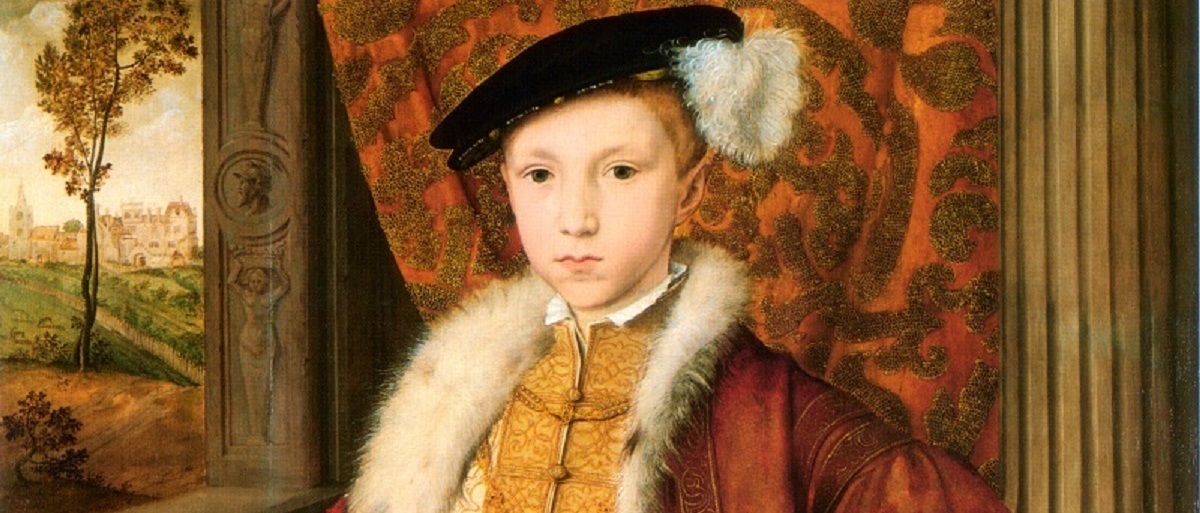Edward VI
Posted on 23rd January 2021
Edward VI was born on 12 October 1537 at Hampton Court, Middlesex, to parents King Henry VIII of England and his third wife Jane Seymour. The country celebrated Edwards birth, for Henry had waited so long for a son.
Edward was christened on 15 October 1537, and became Duke of Cornwall and Earl of Chester.
Although the birth of Edward was a joyous occasion, his mother Jane Seymour fell ill and died, likely from birth complications on 24 October 1537, only twelve days after his birth.
Edward was extremely well cared for as a child as he was precious to Henry; his longed-for male heir to the throne. He received an extensive education and was taught French, Spanish and Italian. He had a keen interest in Geometry and was able to play many musical instruments. He seemed to enjoy his education and to grasp knowledge with ease.
Previous English monarchs had been raised in the Catholic faith, but following Henrys split from the Catholic church, Edward was raised as a Protestant, and would become the first Protestant monarch.
When Edward was only five years-old he was betrothed to the infant Mary, Queen of Scots as part of the Treaty of Greenwich signed on 1 July 1543, to seal peace between England and Scotland. The Scots however reneged on this agreement in December 1543 and allied themselves instead with France.
An enraged Henry then arranged for the invasion of Scotland, a bloody campaign ‘Rough Wooing’ that continued through to 1551.
Edward came to the throne, aged nine on 28 January 1547 following the death of his father Henry VIII.
Reign
The announcement of Henrys death was delayed until after the will had been read, with Parliament not being informed until 31 January 1547.
Edward was now taken to the Tower of London, where he remained until his coronation on 20 February 1547 at Westminster Abbey.
Due to his young age, a Regency Council was formed to govern the country and Edward Seymour, 1st Earl of Hertford and later Duke of Somerset was named as Lord Protector of the Realm.
After two and a half years, Somerset, who had himself been at the forefront of many reformist measures was removed as Lord Protector and later executed. His downfall had been precipitated
Henry VIII had removed the Pope as head of the Church of England, however other than this, little had changed during his reign. The major changes were to come during the reign of Edward VI.
Northumberland now held great influence over Edward and he became instrumental in many of the changes to come. Edward had been raised in the Protestant faith and was determined himself to forge ahead with many reforms.
Many changes were to take place in churches. Much of the elaborate and expensive decorations were removed, including the splendid colours and designs of the stained-glass windows. The ornate furniture was replaced with plain wooden benches, the services were shortened and simplified and were now read in English, not Latin.
The Archbishop of Canterbury, Thomas Cranmer wrote the ‘Book of Common Prayer’ in 1549, a volume containing the forms of daily and Sunday worship. Another major change was that Priests were now allowed to marry.
Cranmer and Northumberland had many reforms still to accomplish, but these were in jeopardy following Edwards illness in 1551. It was later discovered that the illness was terminal, and decisions had to be reached on the succession to the throne.
Edwards half-sister Mary was heir to the throne, but being a devout Catholic, she could destroy the English Reformation, and return England to the Catholic faith.
Northumberland influenced Edward to change the succession away from both his half-sisters Mary and Elizabeth and name Lady Jane Grey, grand-daughter of Henry VIII’s younger sister Mary as his heir.
Northumberland was attempting to secure his own position as Jane was married to his son Guildford Dudley.
Edward died, aged fifteen on 6 July 1553 at Greenwich Palace and is buried in the Henry VII Lady Chapel at Westminster Abbey.
He was succeeded by Lady Jane Grey the ‘Nine Day Queen’, and then by Queen Mary I of England.
Tagged as: Junior Tudors
Share this post:





